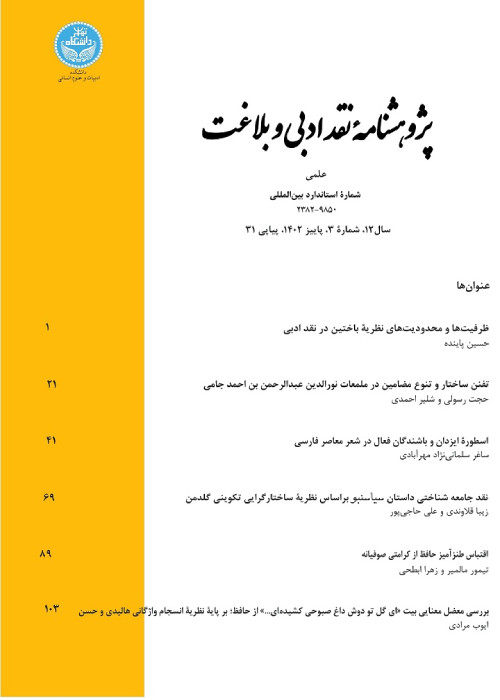The Textual Analysis of Fariba Vafi's My Bird Based on Roland Barthes Semiotic Codes
This paper offers an analytical reading of Fariba Vafi's novel, My Bird. It utilizes the theoretical framework and methodological analysis introduced in Roland Barthes's influential work, S/Z. Specifically, this study utilizes Barthes's introduction of the five semiotic codes of proairetic, hermeneutic, semantic, symbolic, and cultural to analyze the novel through a semiotic/narratological approach. Through this approach, the study aims to define the 'Readerly and Writerly texts,’ to prepare the framework in order to specify whether this work is readerly or writerly, based on Barthes evaluative typology. This study employs the concept of 'Mode of writing' introduced by Barthes in Writing Degree Zero to conduct a narratological analysis of My Bird. Then, the text of the novel is divided into different lexias, which represent the significance of each chosen excerpt in relation to the question being explored. Finally, the paper applies a semiotic analysis to each selected lexia: the proairetic, hermeneutic, semantic, symbolic, and cultural codes to find which one or ones are the more dominant. By dividing the text into different units and analyzing them based on Barthesian typology, the research found that the proairetic code dominates the text, making it a readerly text. While there are a few instances of other semiotic codes, the few semantic codes are mainly similes, meaning that they do not help the reader engage with the chain of signifiers. The scarce number of hermeneutic codes shows that the text lacks an element of mystery that might make the novel interesting for active readers. My Bird offers few examples of symbolic and cultural codes. My Bird can be grouped with feminist literature because it aims to highlight a woman's experience in a patriarchal society. Vafi examines the social, cultural, and political conditions that define gender inequalities in Iran, and My Bird can be seen as a critique of these conditions. The central protagonist of the novel, Roya, is a symbol of this feminist critique, and her story represents the voice of Iranian women. The character's depiction of physical, emotional, and psychological vulnerability is an indication of what many women experience in Iran. But all these are treated formulaically ending in few symbolic and cultural codes.In terms of narrative style, My Bird can be classified as a readerly text based on its proairetic code dominance. The proairetic code is characterized as the code of action, which mostly deals with narration about what happens, what is done or said. The overreliance on this code is a significant factor underlining My Bird's readerly character. The readerly text is easily accessible, traditionally structured, and can be easily understood.The writer's intention is usually to convey his or her message to the reader effortlessly. Barthes's theory of the readerly text aligns with this idea, as the readerly text is designed for a passive reader.Although My Bird is categorically a readerly text, it does include writerly elements that allow for different interpretations. For instance, the limited use of hermeneutic codes in the novel means readers can actively engage in interpretation and potentially find new ways of understanding the text. However, this is not enough to overcome the readerly character of the novel, which is dominated by the proairetic code. Therefore, this research concludes that My Bird is predominantly a readerly text since the proairetic codes are noticeably dominant in the novel. Although the novel includes some writerly elements like hermeneutic codes, My Bird's overarching structure and linguistic devices serve to limit the reader's freedom in interpretation. The research also highlights that the lack of symbolic and cultural codes. The study's findings suggest that My Bird is an unsuccessful example of a readerly text due to its limited potential for active participation from the reader.
- حق عضویت دریافتی صرف حمایت از نشریات عضو و نگهداری، تکمیل و توسعه مگیران میشود.
- پرداخت حق اشتراک و دانلود مقالات اجازه بازنشر آن در سایر رسانههای چاپی و دیجیتال را به کاربر نمیدهد.


